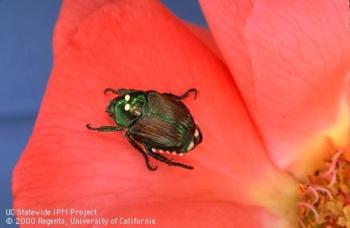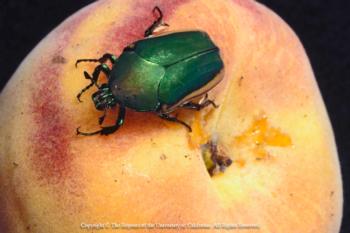INSECT HOT TOPICS: Japanese beetles
by James A. Bethke
For years, California has been avoiding the establishment of a very serious pest, the Japanese beetle (fig. 1), Popillia japonica Newman (Coleoptera: Scarabaeidae). You may be aware of the effort by the CDFA in capturing Japanese beetles in traps at the Sacramento Airport. Indeed, the CDFA collects hundreds of Japanese beetles on aircrafts from infested states every year. Four Japanese beetles were detected in the Fair Oaks area of Sacramento County in 2012, in the same area where they were detected and treated in 2011. On August 28, 2013, an adult male Japanese beetle was unexpectedly trapped in the South Lake Tahoe Airport in El Dorado County. Therefore, El Dorado County was added to the list of infested counties requiring eradication efforts (the other counties are Los Angeles, Merced, Orange, Placer, Riverside, Sacramento, San Bernardino and San Diego counties).
That’s so few beetles, so why all the fuss? It’s mainly because if Japanese beetles become established, they can severely damage a great number of different types of plants (300 plants in 79 plant families) and the soil-borne larvae can severely damage plant roots (which can cause significant damage to turf in lawns, parks, golf courses and pastures). Control of this pest back East is estimated to cost more than $460 million, so the CDFA takes Japanese beetle detection in California very seriously. Additionally, if the Japanese beetle becomes established in California, the movement of nursery stock will be under a set of new phytosanitary requirements.
Adult Japanese beetles are good fliers, active on warm sunny days, and prefer plants that are in direct sunlight. Adults devour flowers, and overripe or wounded fruit and can leave behind skeletonized leaves and large, irregular holes in leaves of trees and other plants. They tend to aggregate and feed at the tops of plants and work their way down. Hosts include a wide variety of plant types such as grapes, stone fruit, raspberry, rose, zinnia, corn,hops, canna, crape myrtles, birch trees and linden trees.
Egg laying begins soon after the adults emerge from the ground and mate. Females leave plants in the afternoon, burrow 2 to 3 inches into the soil in a suitable area, and lay their eggs — a total of 40 to 60 during their life. The developing beetles spend the next 10 months in the soil as white grubs. The grubs develop in the soil, feeding on the roots of various plants, but grasses are particularly favored.
There are some good efforts nationally in an attempt to limit the spread of this serious pest. In 1998 (revised in June 2013), the National Plant Board U.S. Domestic Japanese Beetle Harmonization Plan (DJBHP) was developed by the American Nursery and Landscape Association, U.S. Department of Agriculture and 50 state departments of agriculture (see National Plant Board link below). The purpose of the plan is to assure that the risks of movement of Japanese beetles associated with marketing of nursery stock and other regulated commodities are acceptably managed and are consistent with the National Plant Board Plan Quarantine, Nursery Inspection and Certification (PQNIC) Guidelines.Under this plan, the movement of nursery and greenhouse plants from infested areas needs a state phytosanitary certificate, or an equivalent certification of quarantine compliance, when shipping nursery stock to states that consider Japanese beetle a quarantine pest, such as California. Obviously, if California became a Japanese beetle infested state, it would necessitate that nurseries follow another set of phytosanitary rules, but by doing so, California would avert more stringent requirements.
Lastly, the green fruit beetle (fig. 2), also known as known as green June beetle or fig beetle, is often mistaken for the Japanese beetle in California. For a size comparison between the two beetles, use the link to the CDFA Japanese beetle profile web page below.
Some pertinent web sites:
http://www.cdfa.ca.gov/plant/pdep/target_pest_disease_profiles/japanese_beetle_profile.html
http://nationalplantboard.org/docs/jbcolumn.pdf
http://www.aphis.usda.gov/publications/plant_health/content/printable_version/JB3-07.indd.pdf
http://www.aphis.usda.gov/publications/plant_health/content/printable_version/jbidcard5-07.pdf
http://www.cdfa.ca.gov/plant/pdep/target_pest_disease_profiles/Japanese_beetle_host_list.html
http://en.wikipedia.org/wiki/Japanese_beetle
http://extension.cropsci.illinois.edu/fieldcrops/insects/japanese_beetle/
http://ohioline.osu.edu/hyg-fact/2000/2504.html
http://www.ext.colostate.edu/pubs/insect/05601.html
http://www2.ca.uky.edu/entomology/entfacts/ef451.asp
https://www3.ag.purdue.edu/counties/marion/Pages/JapaneseBeetles.aspx
http://extension.entm.purdue.edu/publications/E-75.pdf
http://www.extension.umn.edu/garden/insects/find/japanese-beetles/
http://www.ces.ncsu.edu/depts/ent/notes/O&T/flowers/note44/note44.html
James A. Bethke is Farm Advisor for Nurseries and Floriculture, UC Cooperative Extension, San Diego and Riverside Counties.












